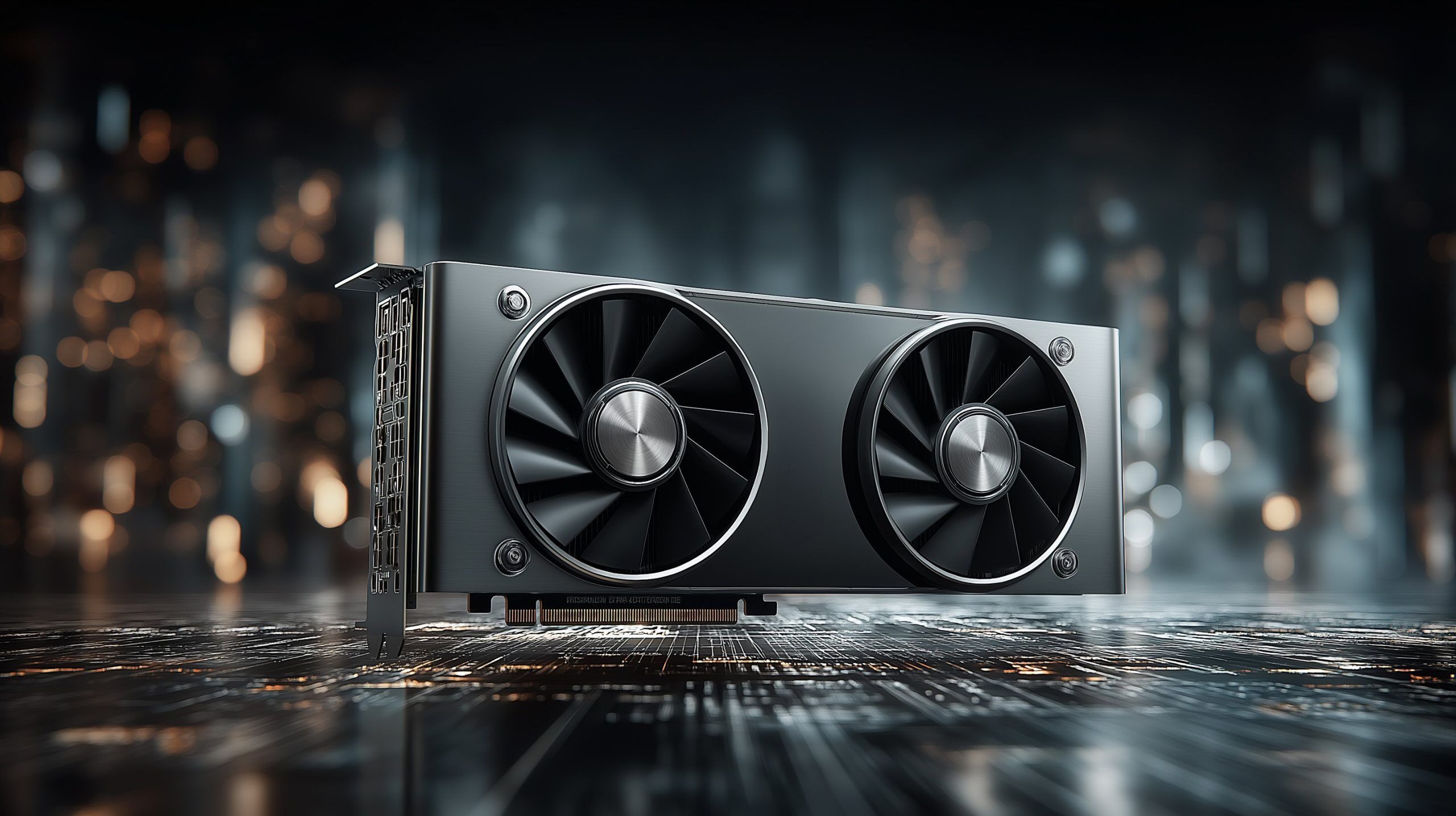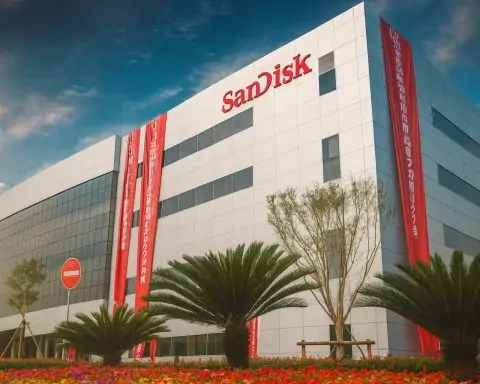- Global semiconductor revenue reached $626 billion in 2024, up 18.1% from 2023, with Gartner projecting about $705 billion in 2025.
- Data-center AI chip sales rose to $112 billion in 2024, up from $64.8 billion in 2023, making generative AI workloads the second-largest semiconductor market after smartphones.
- Memory revenue jumped about 72% in 2024 and accounted for roughly 25% of total market, with HBM revenues expected to grow 66% in 2025 to $19.8 billion.
- TSMC’s 2nm node (N2) is in pilot production with high-volume manufacturing planned for 2H 2025, aiming for about 50,000 wafer starts per month by end-2025, with Apple and NVIDIA among first adopters and nanosheet gate-all-around transistors.
- Intel showcased its 18A Panther Lake prototype at CES 2025, with mass production planned in late 2025 and 18A featuring PowerVia backside power and RibbonFET transistors, while expanding capacity with mega-fabs in Arizona and Ohio and securing about $2.2 billion in U.S. CHIPS Act grants.
- Samsung’s 2nm SF2 node, used in Exynos 2600, reportedly achieved ~30% yield in trial production, with mass production expected by Q4 2025 and a path to 1.4nm around 2027–2028.
- NVIDIA’s 2024 revenue jumped 84% to reach the #3 global semiconductor supplier, driven by AI accelerators and GPUs; H100 GPUs are built on TSMC 4nm with CoWoS packaging, and the GH200 Grace Hopper platform was announced with the Grace CPU shipping in 2025.
- AMD introduced the MI300 family, including MI300A with a 64-core EPYC CPU, CDNA3 GPU, and 128 GB HBM, deployed in the El Capitan exascale system, alongside Zen5 CPUs planned for 2025.
- ASML plans to ship production High-NA EUV tools (EXE:5200) in 2025, with a backlog and each machine containing 100,000+ components, while China remains barred from EUV tools.
- Global government subsidies for semiconductors exceed $250 billion by 2025, including the U.S. CHIPS Act’s $52 billion and the EU Chips Act’s €43 billion, driving a China+1 diversification of supply chains.
Current State of the Industry (Mid-2025) – Summary
The semiconductor industry entered 2025 on a strong upswing after a cyclical downturn in 2022–2023. Global chip revenue hit $626 billion in 2024, up 18.1% from the prior year, and is projected to reach a new record of around $705 billion in 2025 [1] [2]. This growth is propelled primarily by surging demand for AI and high-performance computing (HPC) chips, alongside a rebound in memory chip prices [3] [4]. Generative AI workloads in data centers have quickly become the second-largest semiconductor market (after smartphones), with data-center chip sales jumping to $112 billion in 2024 (up from $64.8 billion in 2023) [5]. At the same time, automotive electronics remain a robust growth engine, and the industry as a whole is well on track toward an aspirational $1 trillion annual market by 2030 [6] [7]. Overall, mid-2025 finds the chip sector in a period of resurgent demand and record investment, tempered by ongoing supply chain adjustments and geopolitical uncertainties.
Technological Advancements Shaping 2025
AI Chips and Accelerators: The explosive adoption of generative AI is reshaping chip design and demand. Specialized AI accelerators – especially GPUs and AI-specific chips – are in extremely high demand for training and running AI models. Industry leader NVIDIA nearly doubled its semiconductor revenue in 2024 (to $46 billion) on the strength of AI accelerator sales [8], and enterprise spending on AI chips is expected to remain a major driver through 2025. Chipmakers are also racing to put AI capabilities into client devices; for example, analysts predict that about half of all new PCs in 2025 will incorporate on-board AI processors (for features like AI-assisted graphics and speech) [9]. Even smartphones are adding AI engines for on-device intelligence – up to 30% of phones sold in 2025 may tout generative AI features [10]. Beyond using chips for AI, companies are using AI for chip design as well. Generative AI tools can optimize circuit layouts and testing, which speed up design cycles and improve efficiency, an approach being adopted by major EDA vendors and cloud providers [11] [12]. In short, AI is both driving new chip products and streamlining the chip development process, a dual impact that marks a key trend of 2025.
Advanced Process Nodes (3nm, 2nm) and EUV Lithography: The industry’s process technology continues to advance into the sub-5nm realm, bringing new materials and tool challenges. 2023 saw the first mass-produced 3 nm chips (e.g. TSMC’s N3 used in Apple devices), and attention is now turning to the 2 nm generation slated to debut in late 2025. TSMC, the leading foundry, has a 2 nm node (N2) in pilot production and expects to ramp high-volume manufacturing in 2H 2025, with Apple and NVIDIA among the first adopters [13]. TSMC’s N2 technology shifts from FinFET transistors to nanosheet (gate-all-around) transistors for better performance and power efficiency [14] [15]. Early reports suggest healthy 2 nm yields, and TSMC aims for ~50,000 wafer starts per month by end of 2025 [16]. Intel is pursuing a similar timeline with its 18A process (roughly equivalent to ~1.8 nm), featuring gate-all-around transistors and backside power delivery. Intel demonstrated its first 18A prototype (the Panther Lake chip) at CES 2025 and plans volume production in late 2025 [17]. Samsung is likewise developing a 2 nm (SF2) node using GAA transistors, after being first to introduce 3 nm GAA in 2022. Samsung’s trial 2 nm chips (Exynos 2600) have reportedly achieved ~30% yield; if progress continues, Samsung could start 2 nm mass production by Q4 2025, close to TSMC’s schedule [18]. These cutting-edge nodes rely heavily on extreme ultraviolet (EUV) lithography. ASML’s EUV scanners remain critical equipment – multiple new EUV tools are being installed to support 3 nm and 2 nm ramps. The next breakthrough is High-NA EUV (higher numerical aperture lenses for finer patterning): ASML delivered the first High-NA EUV prototype tool in late 2023, and the first production-grade High-NA machines (EXE:5200 series) are slated to ship to chipmakers in 2025 [19] [20]. These High-NA EUV systems are enormously complex and expensive (nearly $380 million each) [21], so adoption will be cautious. TSMC, for example, has taken a cautious approach to High-NA EUV, planning to introduce it for its 1.4 nm node around 2027–2028 rather than immediately at 2 nm [22]. Still, continued advances in EUV lithography and transistor architecture (like nanosheet GAA and upcoming backside power techniques) are enabling the industry to stay on track with Moore’s Law scaling through 2025 and beyond.
Chiplets and Advanced Packaging: To keep delivering performance gains amid slowing Moore’s Law, the industry is embracing chiplet architectures – designing chips as modular pieces that can be combined in advanced packages. Rather than a single monolithic SoC die, multiple smaller dies (“chiplets”) can be integrated on an interposer or substrate, connected via high-speed links. This approach improves yields and allows mixing of different process nodes or IP blocks, effectively creating an “SoC on a module” [23]. AMD has been a pioneer of chiplets in its Ryzen and EPYC CPUs, and now many others are on board. In 2024 Intel launched its Meteor Lake PC processors built from multiple tiled dies (CPU, GPU, IO tiles) using Foveros 3D packaging. Broad industry collaboration is underway on standards like UCIe (Universal Chiplet Interconnect Express) to ensure chiplets from different providers can work together. The automotive sector illustrates the promise: advanced driver assistance and infotainment systems need heterogeneous computing (CPU, GPU, AI accelerators) which is hard to achieve on one huge chip. By breaking the system into specialized chiplets, designers can reduce cost and complexity. An industry consortium led by imec’s Automotive Chiplet Program (ACP), with members like Arm and Cadence, is working to standardize chiplet interfaces for automotive-grade designs [24]. Cadence noted that this transformation to chiplet-based design “sets the stage for a new era of innovation” across sectors [25]. Importantly, chiplet architectures depend on advanced packaging technologies (such as TSMC’s CoWoS, Intel’s EMIB/Foveros, etc.) to knit the dies together with high bandwidth. Capacity for such packaging is expanding – for instance, TSMC is boosting its CoWoS packaging capacity to 75,000 wafers/month by end-2025 to meet voracious demand for chiplet-based AI modules [26]. In sum, chiplets and 3D packaging are becoming mainstream by 2025, enabling continued performance scaling and more flexible chip design in an era of rising costs for monolithic scaling.
Rise of RISC-V Open Architecture: RISC-V, the open-source CPU instruction set, has rapidly gained global momentum as an alternative to proprietary ISAs like x86 and ARM. In 2025, RISC-V marks 15 years since inception and is transitioning from niche to mainstream adoption across industries [27] [28]. Its appeal lies in its openness and modular design – companies can customize RISC-V cores without royalties, which is especially attractive amid geopolitical tech restrictions. China has embraced RISC-V as a path to semiconductor self-reliance, given U.S. export controls on advanced ARM CPUs [29]. The Chinese government actively promotes RISC-V, and domestic players like Alibaba’s T-Head have developed high-performance RISC-V cores (e.g. the XuanTie series) including server-class processors [30]. Europe is also investing in RISC-V to bolster technological sovereignty. Approximately one-third of RISC-V International’s members are in Europe, and initiatives like the EuroHPC JU’s projects (e.g. DARE) are building European supercomputers with RISC-V CPUs [31] [32]. Major European chipmakers such as Infineon plan to transition future automotive microcontrollers to RISC-V, moving away from legacy proprietary cores [33] [34]. In the United States and globally, numerous startups and established companies (NVIDIA, Western Digital, Qualcomm, to name a few) are using RISC-V for applications from IoT controllers to AI accelerators. The ecosystem is maturing, with increasing software support (Linux distributions and Android now support RISC-V out-of-the-box) [35] and consortium efforts to standardize extensions for compatibility. Industry forecasts project that RISC-V based chips could generate $90+ billion in revenue by 2030, and by the late 2020s the volume of RISC-V cores shipped may be large enough that open-source royalty-free implementations outpace traditional licensed cores [36]. In short, 2025 finds RISC-V evolving into a truly global ISA, reshaping parts of the computing landscape by lowering entry barriers and enabling regional innovation in processors.
Major Moves by Key Industry Players
TSMC (Taiwan Semiconductor Manufacturing Co.): As the world’s top semiconductor foundry, TSMC is maintaining its technology lead and expanding its global footprint. TSMC’s 3 nm production (N3) ramped up in 2024 for products like Apple’s A17 chip, and the company is on schedule to launch 2 nm mass production in late 2025 [37]. The new 2 nm N2 node uses gate-all-around nanosheet transistors to deliver ~15% better speed and 30–35% power savings vs. 3 nm [38] [39]. To support this, TSMC has built new fabs in Taiwan (Baoshan and Kaohsiung) and expects to reach 50k wafer starts/month on 2 nm by end-2025, scaling to 120k+/month by 2026 [40] [41]. TSMC is also investing heavily in capacity outside Taiwan for the first time: it is constructing advanced logic fabs in Arizona, USA (with support from U.S. CHIPS Act subsidies) and in Kumamoto, Japan (a specialty node fab with Sony/Denso partnership). These projects have faced some delays and higher costs – for example, the Arizona 4 nm fab’s start date slipped to 2025 due to labor and skill shortages – but TSMC is committed to a more geographically diversified manufacturing network. Additionally, TSMC is massively expanding its advanced packaging capacity to meet demand for chiplet-based AI products. Its CoWoS (chip-on-wafer-on-substrate) packaging lines, essential for HBM-integrated AI chips, are being scaled to 3× capacity after running near full utilization in 2024 [42]. Business-wise, TSMC’s revenue mix is shifting: high-performance computing (data center CPUs, GPUs, AI accelerators) has overtaken smartphones as TSMC’s largest end market, reflecting the industry’s new demand drivers [43]. With clear technology leadership, TSMC is on a trajectory to remain the dominant advanced-node foundry through 2025, while navigating geopolitical pressure to localize production.
Intel:Intel is in the midst of an ambitious turnaround plan to regain chip manufacturing leadership and grow its foundry business. Throughout 2024–2025, Intel has been executing on its roadmap of “5 process nodes in 4 years.” After launching its 7 nm-class Intel 4 process (used in 2023’s Meteor Lake client CPUs), Intel is fast-tracking development of its 20A (2 nm) and 18A (1.8 nm) nodes featuring PowerVia backside power and RibbonFET transistors. In early 2025, Intel showcased a prototype Panther Lake chip built on 18A and affirmed that 18A will enter mass production in late 2025 [44]. These nodes are not only for Intel’s own products (like next-gen Core and Xeon processors) but also key to Intel’s foundry services offering – Intel is courting fabless customers to manufacture on Intel 18A as a competitive alternative to TSMC. The company has already won some foundry orders (for example, a deal to produce chips for MediaTek, and partnerships with the US Department of Defense), though it has yet to announce any major cloud or mobile chip client. To expand capacity, Intel is constructing new mega-fabs in Arizona and Ohio (USA) and has a planned fab in Magdeburg, Germany, each supported by government incentives or subsidies. Intel received about $2.2 billion in U.S. CHIPS Act grants for its projects so far [45] [46], and the German government has agreed to substantial subsidies (around €10 billion) for the Magdeburg site. However, Intel’s journey is not without challenges – its 2024 semiconductor revenue was flat at $49 billion [47], as the company lost the top-vendor spot to rebounding memory players. Intel’s client PC and server CPU businesses have faced intense competition, and it was late to the AI accelerator wave (its GPU-based AI accelerators have had limited market traction so far [48]). CEO Pat Gelsinger is nonetheless optimistic that by 2025–2026, Intel will be back to parity or leadership in process technology and will ramp up manufacturing for others. Intel is also doubling down on advanced packaging (notably its EMIB and Foveros technologies) to offer packaging services and to build its own heterogeneous “chiplet” products. 2025 will be a crucial year to see if Intel can execute its process roadmap on time and begin closing the foundry market share gap with TSMC and Samsung.
Samsung Electronics:Samsung is a major player on two fronts – it is both a leading memory chip producer and the #2 global foundry for logic chips. In 2024, Samsung’s semiconductor division saw a significant rebound, with revenue soaring 62% (to $66.5 billion) as memory prices recovered [49]. This put Samsung back at #1 in global semiconductor sales, reclaiming the crown from Intel [50]. On the memory side, Samsung (along with SK Hynix and Micron) had curtailed production in 2023 to counter a glut, which helped drive a sharp upturn in DRAM and NAND prices in late 2024. Notably, Samsung is investing in specialized memory like HBM (High Bandwidth Memory), critical for AI workloads – HBM demand is so strong that Gartner expects HBM revenues to jump 66% in 2025 [51]. On the logic foundry side, Samsung is racing to compete with TSMC’s advanced nodes. Samsung was first to introduce a 3 nm GAA process (in mid-2022), but initial yields were low, and it lost some foundry orders to TSMC. Now Samsung is focusing on its second-generation GAA at 3 nm and on the upcoming 2 nm node planned for late 2025. Early reports from Samsung’s R&D indicate its 2 nm (SF2) yields are ahead of expectations, and trial production of Samsung’s Exynos 2600 on 2 nm has reached ~30% yield [52]. If progress continues, Samsung aims to start 2 nm volume production by Q4 2025, aligning roughly with TSMC’s roadmap [53]. Beyond that, Samsung has outlined a path to 1.4 nm around 2027–2028 (though some sources suggest 1.4 nm might be delayed until the end of the decade) [54]. Strategically, Samsung has shown signs of restructuring to sharpen its competitiveness – for instance, it has reportedly considered separating its foundry business unit to give it more autonomy and focus [55]. Samsung is also expanding production outside Korea: it’s building a fab in Texas, USA (Taylor, TX) and evaluating a potential fab in Europe, capitalizing on government incentives. Finally, in automotive and mobile markets, Samsung LSI continues to develop chips (like mobile processors and image sensors), and it recently launched new auto-grade memory (LPDDR5X) for advanced vehicles [56]. Overall, Samsung in 2025 is bolstering its positions – regaining memory leadership and striving to close the gap with TSMC in cutting-edge logic processes.
NVIDIA:NVIDIA has emerged as one of the biggest winners of the AI era, now firmly entrenched among the world’s top semiconductor companies. In 2024 NVIDIA’s revenue skyrocketed +84%, propelling it to the #3 position in global semiconductor sales (behind only Samsung and Intel) [57] [58]. This surge is driven almost entirely by insatiable demand for NVIDIA’s AI accelerators and GPUs. Its flagship H100 GPUs (built on TSMC 4 nm with advanced CoWoS packaging) became the de facto standard for AI model training – so much so that cloud providers and enterprises snapped up every H100 Nvidia could supply, with orders booking out well into 2024–2025. NVIDIA has been rapidly launching products to capitalize on the AI boom: in late 2024 it unveiled the GH200 “Grace Hopper” platform combining a Hopper GPU with a Grace CPU and high-bandwidth memory, targeting giant AI and HPC workloads. For 2025, NVIDIA is expected to introduce next-generation GPU architectures (the rumored Blackwell generation) to further boost AI performance per watt. The company is also expanding its portfolio beyond GPUs. Its Grace CPU (a custom Arm-based server CPU) will begin shipping to compete in AI and cloud servers (often paired with GPUs). NVIDIA’s foray into networking and data center interconnect (after acquiring Mellanox) means it now sells DPUs (data processing units) and high-speed Ethernet/NVLink switches, providing more of the AI data center’s “plumbing.” In the automotive sector, NVIDIA’s DRIVE platform has design wins in autonomous vehicle programs, and the upcoming Thor SoC aims to unify self-driving and infotainment functions on one chip. Despite being fabless, NVIDIA’s influence on semiconductor manufacturing is significant – its needs are driving TSMC to invest in more capacity and packaging capabilities [59], and the short supply of NVIDIA’s AI GPUs in 2024 even prompted some nations (e.g. China) to accelerate indigenous chip efforts. NVIDIA’s market capitalization briefly topped $1 trillion, reflecting investor belief that AI silicon will be a multi-year growth engine. Heading into late 2025, NVIDIA’s challenges will include looming competition (from AMD, Google TPUs, startups, etc.) and navigating export controls (its top-bin AI chips like H100/A100 are now restricted from China, forcing NVIDIA to offer modified lower-speed versions like A800 for that market). Still, as of mid-2025, NVIDIA is riding an unprecedented wave – arguably the central player in the current semiconductor upswing, thanks to AI.
AMD:AMD continues to solidify its role as a high-performance computing powerhouse, aggressively competing with both Intel and NVIDIA across different segments. In CPUs, AMD’s EPYC server processors (built on TSMC 5 nm/6 nm with chiplet designs) have steadily gained data center market share at Intel’s expense through 2024. AMD’s roadmap in 2025 includes new “Zen 5” CPU core products, which will span server chips (the Turin EPYC family) and client CPUs, likely manufactured on advanced 4 nm or 3 nm nodes. AMD is a leader in chiplet architecture – its use of multiple smaller dies has given it a cost and yield advantage. That approach is extending into GPUs and adaptive chips as well. A major play for AMD in 2025 is the MI300 series accelerators, which are multi-die modules combining CPU, GPU, and HBM memory in one package (sometimes called an APU for the data center). The MI300A, for example, integrates a 64-core EPYC CPU with a CDNA3 GPU and 128 GB of HBM, targeting AI and HPC workloads (this is being deployed in the El Capitan exascale supercomputer). AMD is positioning MI300 as a strong competitor to NVIDIA’s high-end accelerators for training AI and for military/aerospace uses where an alternative to NVIDIA is sought. Early reports indicate significant interest, though NVIDIA still holds a software ecosystem advantage. AMD’s CEO Lisa Su is bullish on the AI market – she estimates the total addressable market for AI accelerators could reach $150 billion by 2027, and AMD aims to capture a sizable slice of that [60]. In addition, AMD now encompasses FPGA and adaptive computing expertise from its 2022 acquisition of Xilinx. This allows AMD to offer adaptable chips for 5G, aerospace, and AI inference (where FPGAs can be useful). In client PCs and gaming, AMD’s Radeon graphics and Ryzen processors face stiff competition (NVIDIA and Intel respectively), but the company’s focus is clearly on the higher-margin data center side in 2025. Financially, AMD benefited from the 2024 upswing (especially with robust semi-custom chip sales for gaming consoles and some AI GPU wins), and it sits among the top 10 semiconductor vendors by revenue. The key to AMD’s continued success will be executing its product roadmap (Zen 5, Zen 6, MI300, etc.) and further leveraging its chiplet and packaging innovations to deliver performance-per-dollar leadership.
Qualcomm:Qualcomm remains the leading supplier of mobile phone chipsets, but in 2025 it is actively diversifying its portfolio as smartphone growth moderates. Qualcomm’s flagship Snapdragon system-on-chips power a majority of premium Android phones, and the company continues to advance these designs on cutting-edge TSMC processes (the latest Snapdragon 8 series uses TSMC 4 nm, and a 3 nm-based next generation is expected). These mobile SoCs now emphasize on-device AI processing (for camera, voice, etc.), aligning with the trend of AI at the edge. However, global smartphone shipments have been relatively flat, so Qualcomm is pushing into new markets. A big move is into PC processors: in late 2024 Qualcomm announced the Snapdragon X Elite, an Arm-based laptop CPU built on Nuvia’s custom core design, aiming to challenge Apple’s M-series and Intel/AMD in Windows PCs. Products launching in 2025 with this chip will test Qualcomm’s ability to grab a piece of the PC market with promises of high performance and efficiency. Qualcomm is also heavily invested in automotive chips. Its Snapdragon Digital Chassis platform (combining connectivity, infotainment, ADAS, and autonomy) has garnered design wins with carmakers. For instance, many new vehicles use Qualcomm’s SoCs for their infotainment systems, and Qualcomm’s ARRIVER acquisition added advanced driver-assistance algorithms to its portfolio. The automotive semiconductor TAM is growing, and Qualcomm expects significant revenue from this segment in coming years. Another area is IoT and wearables – Qualcomm offers Snapdragon chips for AR/VR headsets, smartwatches, and industrial IoT, leveraging its wireless expertise (5G, Wi-Fi, Bluetooth). In the 5G domain, Qualcomm remains a key patent holder and supplies many of the RF and modem chips for phones and connected devices. (Apple has been trying to internalize modem production, but as of 2025 Qualcomm is still providing 5G modems for iPhones.) On the technology front, Qualcomm has shown interest in RISC-V for certain products and joined RISC-V alliances, indicating a willingness to use whatever ISA best fits (while its core application processors remain Arm-based for now). Financially, Qualcomm’s 2024 revenues were solid – it ranked #5 globally [61] – thanks to a combination of mobile and growing automotive sales. The challenge ahead will be maintaining leadership amid new competitors in mobile (e.g. Google’s Tensor chip, in-house OEM designs) and scaling its presence in PCs and cars. Nonetheless, Qualcomm’s strong IP portfolio in wireless and its strategic expansion into PC and automotive semiconductors position it as a key player to watch in 2025.
ASML:ASML of the Netherlands is not a chip maker but is a lynchpin of the global semiconductor supply chain as the sole provider of cutting-edge EUV lithography tools. In 2025, demand for ASML’s lithography equipment – both deep-UV (DUV) and EUV – remains at record highs due to worldwide fab construction. Leading chipmakers TSMC, Samsung, and Intel have all placed orders for ASML’s next-gen EUV systems to enable their 2 nm-class processes. ASML achieved a milestone by shipping the first High-NA EUV scanner (EXE:5000 series) for R&D use in late 2023 [62]. By mid-2025, it plans to deliver the first production High-NA tool (EXE:5200) to a customer (likely Intel, which has publicly announced receiving High-NA tools) [63] [64]. High-NA EUV will allow finer chip features with fewer exposures, critical for sub-2 nm nodes, although initial adoption will be limited due to complexity and cost. ASML’s order backlog extends years out, and it has scaled up manufacturing to produce more EUV machines per year than ever before – yet it cautions that output is constrained by an intricate global supply chain (each EUV machine has 100,000+ components sourced from across Europe, Asia, and the US). Geopolitically, ASML is directly affected by export control policies. The Dutch government (under US pressure) has banned ASML from selling its most advanced machines to China; notably, China has never received an ASML EUV tool due to restrictions in place since 2019. In 2023, the Netherlands expanded restrictions to certain advanced DUV models as well [65]. This means Chinese foundries like SMIC cannot access the latest lithography, potentially capping their progress at ~7 nm using older equipment. Despite losing the China market for EUV, ASML’s business with other regions is booming – U.S. and European subsidy-driven fab projects (Intel, TSMC, Samsung, GlobalFoundries, etc.) are all clients. ASML is also developing future lithography technologies beyond EUV, such as research into High-NA EUV successors and maskless lithography, but those are many years away. In the near term, ASML’s priority is to fulfill the surge of orders and support customers’ aggressive roadmaps. The company’s unique position continues to yield strong financial performance, and it remains one of the most strategically important vendors in the semiconductor ecosystem going into 2H 2025.
Geopolitical Developments and Supply Chain Dynamics
U.S.–China Tech Tensions: Geopolitics continues to profoundly shape the chip industry in 2025. The United States has steadily tightened export controls to limit China’s access to advanced semiconductors and equipment, citing national security. Since 2019, a series of U.S. rules have restricted cutting-edge chip technologies – from EUV lithography and high-end EDA software to state-of-the-art AI chips – from being supplied to China [66]. In October 2022, the U.S. introduced sweeping rules blocking export of GPUs above certain performance thresholds to China, prompting NVIDIA to create reduced-performance versions (A800, H800) for the Chinese market. The U.S. also convinced key allies (Japan, Netherlands) to join in curbing critical chip tool exports to China in 2023. These controls were escalated in late 2024, when the U.S. administration issued new rules on AI technology diffusion and chipmaking chemicals, further closing loopholes [67]. By January 2025, additional “Interim Final Rules” were announced to tighten AI chip export controls and likely ban sales of even the pared-down versions to China [68]. China, for its part, has accelerated efforts to achieve self-sufficiency in semiconductors. The Chinese government poured large investments into domestic fabs, chip design startups, and indigenous equipment. Companies like SMIC have managed to produce 7 nm-class chips using older DUV tools and extra patterning, albeit at low volume, as evidenced by a 2023 Huawei smartphone chip. However, without access to EUV and top-tier tools, China’s leading-edge capabilities face limitations. In response to U.S. actions, China has also retaliated in targeted ways – for instance, imposing export restrictions on critical minerals (like gallium and germanium in mid-2023) that are used in chip manufacturing, and launching a security review that effectively banned Chinese government purchases of certain U.S.-made chips. Geopolitical tensions around Taiwan (home of TSMC and more than 90% of cutting-edge chip capacity) remain an underlying concern; any disruption there would reverberate globally. As a hedge, both U.S. and Chinese officials have explored contingency plans (the U.S. has reportedly discussed evacuating TSMC engineers in a crisis, while China works on “Plan B” suppliers). The net effect of U.S.–China tensions is a partial “tech decoupling” – with China focusing on older-node chips (which are still widely used in cars, IoT, etc.) and exploring open-source tech like RISC-V to reduce Western dependencies [69], while the U.S. and allies funnel advanced tech among themselves. This has injected uncertainty but also led many companies to adopt a “China +1” strategy for manufacturing. As of 2024, 80% of high-tech firms had executed plans to diversify supply chains away from over-reliance on China [70] [71]. Popular alternatives include Vietnam, India, and Mexico for production, as companies seek to regionalize supply chains (APAC for APAC, US for US, etc.) [72].
CHIPS Act and Allied Industrial Policies: In an effort to bolster domestic semiconductor capacity and reduce dependence on Asia, many governments have enacted subsidy programs – the most notable being the U.S. CHIPS and Science Act of 2022. The CHIPS Act set aside $52 billion (including $39 billion in direct subsidies for fabs) to incentivize chip manufacturing and R&D in the United States [73] [74]. By early 2025, this has led to a wave of fab projects: Intel, TSMC, Samsung, GlobalFoundries, Micron and others have all announced new U.S. facilities, many with CHIPS grants. However, the program’s rollout has been complex – as a new administration took office in 2025, there were moves to review and potentially revise CHIPS Act award conditions (such as requirements for union labor and limits on companies’ investments in China) [75] [76]. The White House even delayed some funding disbursements pending this review [77]. Despite some policy swings, the direction is clear: the U.S. is determined to onshore more semiconductor production for economic and security reasons. In parallel, Europe launched its own EU Chips Act, a €43 billion initiative aiming to double Europe’s global semiconductor market share by 2030. This has attracted Intel (with the big Germany fab plan), STMicroelectronics (expanding in Italy and France), GlobalFoundries (in France), and TSMC (considering a fab in Germany in partnership with NXP/Infineon). Japan has invested heavily too – backing the new chip venture Rapidus, which, with IBM’s technology, is aiming for 2 nm production in Japan by 2027 [78]. Japan also secured TSMC’s commitment to build a specialty fab (finishing by 2024) and is supporting memory makers like Kioxia. South Korea, while home to Samsung and SK Hynix, passed its own incentives (the K-Chips Act) offering tax breaks to chip investments. India has rolled out a semiconductor mission with large subsidies to entice a major fab (though as of 2025, no leading-edge fab is confirmed there yet). Taiwan, for its part, introduced new tax credits to keep advanced investments at home, trying to offset the pull of overseas subsidies. All these policies amount to a historic wave of government intervention – over $250 billion in chip subsidies globally have been pledged [79] – in what some call a new “chip arms race.” The goal is to build a more geographically balanced production footprint, improving supply-chain resiliency after the shocks of the pandemic chip shortages. By the second half of 2025, many of these projects are under construction but not yet online – meaning the supply landscape will meaningfully change in 2026–2027 when new fabs in the U.S., Europe, and elsewhere begin production. In the meantime, the concentration of leading-edge capacity in East Asia (Taiwan, South Korea) remains a potential single-point-of-failure, which keeps geopolitical risk top of mind for industry planners.
Supply Chain Diversification and “Friendshoring”: To adapt to both geopolitical and pandemic lessons, companies throughout the semiconductor value chain are diversifying their manufacturing and sourcing. This includes materials (e.g. finding non-Chinese sources for rare earths and critical minerals), equipment (chipmakers stockpiling parts and working with multiple tool vendors where possible), and assembly/test (relocating some OSAT operations to places like Vietnam, Malaysia, or even the U.S.). The “friendshoring” concept – basing supply networks in allied or stable countries – has gained traction. For instance, TSMC and Samsung both agreed to build fabs in the U.S.; ASE (a major chip packaging firm) opened new capacity in Mexico; and automakers forged partnerships to have chip production in-region after the auto chip shortage fiasco. The China+1 strategy mentioned earlier has led to significant shifts: Vietnam and India have seen upticks in semiconductor packaging and design activity, and Mexico is benefitting due to proximity to the U.S. market [80] [81]. However, moving high-tech manufacturing is slow and costly – a new fab takes 3–5 years to become operational [82]. Thus, in 2025 the industry is in a transition phase of supply chain reorganization. Companies are balancing efficiency vs. resilience: carrying higher inventory and dual-sourcing key components to avoid the kind of shortages experienced in 2020–2021. Government policies (like potential new U.S. tech tariffs or export bans) remain a wildcard that could quickly alter cost structures. Overall, expect geopolitics to continue exerting strong influence on where chips are made and who has access to what technology. The short-term outlook (next 1–2 years) sees continued uncertainty and strategic maneuvering, but in the long run these moves could create a somewhat more distributed – if less globally optimized – semiconductor supply chain [83].
Market Performance and Outlook for 2025
Sales Rebound and 2024–2025 Growth: After a downcycle in 2022–early 2023, the semiconductor market swung back to growth in late 2023, and the recovery accelerated into 2024. According to Gartner, 2024 semiconductor revenue totaled $626 billion, up 18.1% from 2023 [84]. This sharp rise was driven by two main factors: a booming demand for AI/data center chips and a strong recovery in memory (which had crashed in 2022–23). For 2025, industry analysts generally predict continued growth, though at a more moderate double-digit pace. Gartner forecasts +12.6% growth in 2025 to about $705 billion [85], while IDC is slightly more bullish at +15% [86]. Some others are more cautious – for example, Semiconductor Intelligence (SC-IQ) projects around 7–8% growth in 2025, noting potential slowing in 2026 [87]. In broad terms, most see 2025 as a growth year (high-single to low-double digit percentage gains), building on the 2024 upturn [88] [89]. The industry remains cyclical, but the emergence of new demand drivers (AI, automotive) is helping smooth out the historical PC/phone-driven swings. Indeed, by hitting ~$700B in sales in 2025, the sector is aligning with the trajectory needed to reach ~$1 trillion by 2030 (requiring ~7–8% CAGR) [90].
Segment Trends – Memory vs. Logic: One striking aspect of the 2024–2025 upcycle is the outsized growth of the memory sector. After a severe glut in 2022 that saw prices plummet, memory chip revenue roared back starting late 2023. In 2024, memory (DRAM, NAND, etc.) saw an estimated +72% surge in revenue [91], far outpacing the ~7% growth in non-memory logic chips. This meant memory’s share of total semiconductor sales jumped from about 20% in 2023 to 25% of the market in 2024 [92]. The rebound was led by DRAM, especially specialty DRAM like HBM (used for AI accelerators) and DDR5 (for PCs/servers). Gartner notes HBM is capturing a growing portion of DRAM dollars and expects HBM revenues to grow another 66% in 2025 (to ~$19.8 billion) as AI demand stays hot [93]. NAND flash also recovered, though more gradually, as excess inventory cleared. On the logic side, the picture is more mixed by end market. Data center logic (CPUs, GPUs, ASICs for cloud) nearly doubled, with data center semiconductor sales reaching $112 billion in 2024 (up ~72%) [94] – this encompasses the AI accelerators, server processors, and networking chips all surging to equip new AI servers. In contrast, consumer and mobile segments were sluggish: smartphone unit sales in 2024 roughly flat (1.24 billion units, +6% YoY after a weak 2023) [95] and PC sales just began to rebound (about 260–273 million PCs in 2024, +4%) [96]. For 2025, PCs are expected to grow a few percent (as enterprise upgrade cycles and Windows refreshes help) [97], and smartphones low single-digit growth – meaning these traditional drivers won’t be major growth contributors. Automotive chips continued their steady climb: 2024 saw record auto semiconductor sales as car production recovered and semiconductor content per vehicle keeps rising. Auto semiconductor revenue grew by an estimated high-teens percent in 2024, and projections for 2025 are for ~10% growth as EV adoption and ADAS content increase (even if vehicle unit sales grow modestly) [98] [99]. Industrial and IoT markets were mixed – industrial electronics demand softened in early 2024 with macroeconomic slowdowns, but IoT and automation investments are a secular trend providing a baseline growth in the mid-single digits. Consumer electronics (TVs, appliances) remained a weak spot due to high inventories and inflation dampening demand.
In summary, 2024’s growth was very top-heavy – data center and memory did the heavy lifting, while consumer/mobile was tepid. In 2025, we expect broad-based (if uneven) growth: memory and AI-related logic should continue to outpace other categories, though likely not at the extreme rates of 2024’s initial snap-back. If memory prices hold or rise further, the memory segment could see another 20%+ revenue jump in 2025 (some forecasts say ~24% growth [100]). Logic IC growth might be on the order of mid to high single digits overall, with high-end logic (5 nm and below) staying capacity-constrained (strong pricing power) and some older-node sectors facing more normalized supply.
Capacity Utilization and Investment: In early 2023, parts of the industry were dealing with excess capacity – e.g. many 200 mm and older 28 nm-class lines were underutilized when consumer electronics slumped. Memory makers dramatically cut wafer starts to stop price free-fall. By mid-2024, the situation flipped: leading-edge foundry capacity (7 nm, 5 nm, 4/3 nm) was highly utilized thanks to AI and high-end smartphone chip demand, and memory fabs began ramping up utilization as inventories normalized. TSMC, for instance, saw a softer utilization on some consumer-oriented nodes (like 6 nm/7 nm) in early 2024 but full utilization on advanced and specialty capacity (CoWoS packaging lines for AI chips even had backlogs) [101]. Going into late 2024 and 2025, utilization is expected to improve across the board, with most fabs running near full capacity – except a few areas like legacy nodes that still have a slight overhang. The industry has responded with record capital expenditures over the past few years. After a peak capex in 2022 (~$190 billion industry-wide), companies trimmed spending in 2023 (especially memory firms slashed capex by ~50%). Now in 2024–25, capex is rising again, focused on both advanced logic and new memory node transitions (e.g. to 1β DRAM, 200+ layer NAND). Foundry leader TSMC alone plans $32–36 billion capex in 2024 and similar in 2025, largely for 2 nm and advanced packaging expansions. Samsung and SK Hynix also announced increases in investment for 2024–25 after cutting in 2023. The global 300 mm fab capacity is forecast to hit an all-time high by 2025, and continue climbing to a projected 9.8 million wafers/month by 2028 as new fabs come online [102]. Notably, a chunk of new capacity will be in China (mostly older tech nodes) since Chinese fabs have been ramping aggressively to meet domestic needs despite restrictions. For example, SMIC expanded 28 nm and 40 nm capacity in 2024, and YMTC (NAND maker) resumed expansion. However, much of the leading-edge capacity growth through 2025 will be at TSMC and Samsung’s home bases, as Intel’s and TSMC’s U.S. fabs won’t output significant volume until 2026.
Pricing Trends: The pricing environment in 2024–25 reflects the crossing of supply-demand curves in different segments. Memory prices (both DRAM and NAND) hit multi-year lows in early 2023, then stabilized and started rising by Q3 2024 as producers cut output. By 2025, DRAM contract prices are expected to gradually rise but likely remain below previous peak levels – OEMs are wary of overstocking, and new nodes (like 1α/1β DRAM) will add bit supply. NAND flash pricing remains more pressured (due to more aggressive bit growth and more suppliers), but even there a mild uptrend is forecast into 2025. For logic/foundry chips, pricing had significantly increased during the 2021 shortage (foundries raised wafer prices 10–20%). In 2023, some foundries froze or slightly reduced prices for older nodes to retain customers as supply loosened. On the leading edge, however, wafer prices have stayed high – a 5 nm wafer can cost over $17,000, and 3 nm is even higher – reflecting both the scarcity and the huge R&D cost. TSMC hinted at more narrow pricing increases or flat pricing in 2024–25 as its customers manage their margins. One exception is that competition from Intel’s upcoming foundry offerings may introduce pricing pressure in the future, but in 2025 Intel’s capacity is limited, so TSMC and Samsung still have pricing power. In automotive MCUs, an area that saw extreme shortages in 2021, pricing has stabilized but not fully reverted – auto chip suppliers (Infineon, NXP, etc.) renegotiated some contracts at higher base prices, citing the need for capacity investment, and those prices largely hold in 2025. GPU prices for AI remain stratospheric – an NVIDIA H100 board could sell for well above list price due to scarcity, and cloud providers have even reported secondary market mark-ups. As more supply becomes available in 2025 (including potential new entrants’ GPUs), these could moderate, but high-end AI compute is likely to command premium pricing for some time. Finally, chip equipment prices (like those of ASML tools) have inflated due to low volume and high demand; those costs feed into the wafer prices longer term.
Market Forecasts and Analyst Views: Industry analysts and market research firms are generally optimistic that the semiconductor market will continue expanding in the second half of 2025 and beyond, albeit with some normalization after the extraordinary AI-driven spike. Gartner expects the market to reach $705 billion in 2025 and continue growing at a healthy pace through 2026 [103]. IDC similarly cites AI and memory recovery for projecting mid-teens growth in 2025, but they also warn of potential inventory corrections in late 2025 as supply catches up [104] [105]. The Semiconductor Industry Association (SIA) and WSTS (the World Semiconductor Trade Statistics) point to broad-based demand from emerging technologies (AI, 5G, EVs) sustaining a long-term ~6–10% annual growth range. Interestingly, some analysts caution about 2026 – after two strong years, the industry could see a mild cyclical slowdown if capacity overshoots demand (especially in memory). For now, though, the consensus is that 2025 will be a growth year, with several firms (McKinsey, KPMG) labeling it as a return to a “high-growth trajectory” for the industry post-pandemic [106]. One new trend in analysts’ commentary is the concentration of profits: McKinsey highlighted that in 2024 the top 5% of chip companies captured essentially all the industry’s economic profit, mainly thanks to AI, while many smaller firms saw profit declines [107] [108]. This suggests that while revenue is up broadly, the value is accruing to leaders in the most in-demand segments (e.g., NVIDIA, TSMC, ASML, Broadcom) [109]. If this continues, 2025 may see more consolidation or shifts as companies seek to move into the lucrative AI and data center space to improve their share of the profit pool.
Emerging Use Cases Driving Semiconductor Demand
Artificial Intelligence and Machine Learning: AI is the killer app of the moment for the chip industry. Training large AI models (like GPT-4 class language models) requires massive compute clusters filled with GPUs or AI accelerators, directly translating to demand for high-end processors, memory (HBM), and networking silicon. Moreover, the inference side of AI – running models in production – is spreading AI chips everywhere: data centers, edge servers, PCs, and even mobile devices. In cloud and enterprise data centers, 2024–2025 saw unprecedented investment in AI infrastructure (some hyperscalers doubling capital spend, largely for AI hardware). This drove not only the obvious GPU/accelerator sales but also upgrades in supporting chips: CPUs with AI extensions (to better handle AI tasks), SmartNICs/DPUs for offloading network processing in AI clusters, and optical interconnects to link AI servers (a niche but growing segment) [110]. On the client side, new smartphones and laptops now tout on-device AI capabilities – e.g. image recognition, language translation, voice assistant improvements – all enabled by built-in AI engines. Qualcomm, Apple, Google, and MediaTek have all enhanced the AI DSP/NPU blocks in their mobile SoCs to handle these tasks. AI is also driving new chip architectures: from tensor processing units (TPUs) to neuromorphic chips and graph processors, startups and incumbents are innovating designs tuned for machine learning algorithms. Even memory is affected: AI workloads prefer faster memory, hence GDDR6, HBM, and next-gen non-volatile memories (for storing huge AI models) are hot areas. With generative AI adoption still in early stages across industries (finance, healthcare, manufacturing are all exploring AI uses), the semiconductor demand from AI is expected to stay on a steep upward trajectory through 2025 and beyond. Notably, AI intersects with many other use cases (autonomy, IoT analytics, etc.), making it a foundational driver cutting across segments.
Automotive and Electric Vehicles: The automotive sector’s importance to the chip industry has grown markedly, as modern vehicles require a wide array of semiconductors. The push toward electric vehicles (EVs) and advanced driver-assistance systems (ADAS) has led to significantly higher semiconductor content per car. An electric vehicle can have 2–3× the silicon content of a traditional internal combustion car, due to power electronics (for battery management and motors), more sensors, and richer infotainment systems. ADAS features (like lane assist, collision avoidance, adaptive cruise) rely on cameras, radar, lidar, and powerful onboard processors to interpret data – all adding to chip demand. Some high-end cars in 2025 will even feature L3 or L4 autonomous driving chips, such as Tesla’s FSD computer or NVIDIA’s Orin/Thor, which are essentially supercomputer-level chips hardened for automotive use. Automotive semiconductors span a range: robust MCUs (often on older nodes like 28 nm but with special reliability), high-performance SoCs (on 7 nm or 5 nm for autonomy and infotainment), analog and power chips (Si and emerging SiC/GaN devices for EV power management). The supply chain issues of 2021–2022 made automakers keenly aware of chips – now many car companies have direct partnerships or investments with chip suppliers to secure supply. For example, GM has a deal with GlobalFoundries for a dedicated capacity on auto-qualified process, and multiple OEMs (Mercedes, Toyota, etc.) have collaboration with NVIDIA, Qualcomm, and Intel/Mobileye for next-gen car compute. By second half of 2025, despite a potential plateau in global car unit sales, the value of chips per car continues to increase, meaning automotive semiconductor demand grows faster than car volumes. Analysts see automotive as one of the most steady growth segments (~8–12% annual growth) for the coming years [111]. The pipeline of emerging use cases – fully autonomous driving, vehicle-to-everything (V2X) communication, and connected car services – will further entrench semiconductors as the “new oil” of the auto industry.
Internet of Things (IoT) and Edge Computing: The IoT revolution – connecting billions of devices and sensors – is a long-term driver for a high volume of chips, albeit mostly lower-cost, specialized ones. IoT devices range from smart home appliances and wearables to industrial sensors and smart city infrastructure. In aggregate, these use huge numbers of microcontrollers (MCUs), connectivity chips (Wi-Fi, Bluetooth, Zigbee radios), and various sensors (MEMS chips for motion, pressure, etc.). The trend in 2025 is towards more intelligence at the edge: rather than just gather data, devices do local processing. This has given rise to “TinyML” – running machine learning on microcontrollers – and has spurred chip designers to integrate AI/ML accelerators into IoT-class SoCs. We see new IoT processors with NPUs for tasks like voice recognition in wireless earbuds or predictive maintenance algorithms on factory sensors. The rollout of 5G networks also enables more IoT use cases (like massive IoT and low-latency apps), and the upcoming 5G Advanced and early 6G research focus on connecting vast numbers of devices efficiently. That means ongoing demand for wireless infrastructure chips (from base station radios to core network ASICs) as well as the IoT client devices. Edge computing refers to processing closer to where data is generated (as opposed to in a central cloud). In 2025, this is expanding – examples include content delivery networks with edge servers, factory floor computing hubs, and telco edge data centers for latency-sensitive apps. These edge deployments need similar chips to cloud data centers (CPUs, accelerators, FPGAs for realtime processing), just in smaller form factors or rugged packages. The convergence of IoT and edge is exemplified by things like edge AI appliances – small boxes with a couple of GPUs or VPUs (vision processing units) that sit on premises (say, in a retail store or hospital) and run AI inference locally. All of these contribute to semiconductor demand in a somewhat distributed fashion: no single IoT application moves the needle, but collectively IoT/edge could account for a significant share of chip unit shipments. Moreover, IoT growth benefits analog and sensor chip makers (TI, Analog Devices, NXP, STMicro, etc.), which in turn drives fab utilization at mature nodes. As of 2025, the IoT device installed base is in the tens of billions globally, and with factories and cities getting smarter, this will only grow – ensuring a persistent, if diffuse, demand for semiconductors from the edge.
High-Performance Computing (HPC) and Cloud: Beyond AI, the broader HPC market (scientific supercomputing, cloud computing, and big data analytics) continues to push the envelope of chip performance. National labs are deploying exascale supercomputers (each capable of >10^18 operations/sec) – these machines, such as the U.S. Frontier and El Capitan or China’s prototype exascale systems, utilize thousands of cutting-edge CPUs and GPUs, driving demand for the latest chips from AMD, Intel, NVIDIA, and specialized interconnects. HPC requirements often overlap with AI, but there are unique drivers: for example, weather modeling, protein folding simulations, and crypto/security applications might use custom accelerators (like ASICs or FPGAs) tuned for those tasks. The cloud computing industry (hyperscalers like AWS, Google, Microsoft, Alibaba) is another engine of chip demand, as they build out data center capacity. In recent years, cloud providers have started designing their own chips to optimize specific workloads – e.g. AWS Graviton (Arm-based CPU), Google TPU (ML accelerator), Microsoft’s rumored AI chip “Athena”, etc. This trend of vertical integration means even more leading-edge chips being produced (often by TSMC) for in-house use by cloud companies. Meanwhile, cloud growth drives the need for networking and storage silicon – 400G/800G data center switch chips (from Broadcom, Marvell), high-end Ethernet NICs and SmartNICs, fiber optic modules (with laser driver chips, etc.), and SSD controllers for the vast storage farms. All these fall under HPC/cloud infrastructure. Demand outlook for HPC/cloud remains robust for 2025, though one caveat: if global economic conditions tighten IT budgets, cloud providers might moderate spending (there were reports of some digestion of cloud capacity in early 2023). Still, given the strategic importance of AI and digital transformation, most analysts expect cloud and HPC investments to grow in the high single or double digits through 2025. HPC is also increasingly important for national security, driving government funding for advanced chip research (as seen in US DOE funding new designs, EU’s EuroHPC projects, etc.). In summary, emerging use cases like AI, autonomous vehicles, IoT, edge and HPC are not just buzzwords – they are active contributors to semiconductor growth, picking up the slack from any plateauing legacy markets and creating new opportunities for innovation and revenue.
Industry Outlook and Analyst Perspectives
The outlook for the semiconductor industry in the latter half of 2025 and beyond is broadly positive, as multiple secular drivers keep demand on an upward trajectory. Analysts from major firms and research organizations highlight that chips are becoming ever more essential to the modern economy – from powering AI breakthroughs to enabling the energy transition (EVs and smart grids) – which underpins a strong growth thesis. Deloitte projects 2025 will set a new revenue record near $700 billion and notes that the industry is well on pace for $1 trillion by 2030, requiring only around 7.5% CAGR going forward [112]. Gartner likewise is bullish, pointing to generative AI and automotive as transformative forces driving new demand, and forecasting double-digit percentage growth for the global chip market in both 2025 and 2026 [113]. Market research from Gartner underscores how AI has elevated data centers to the second-largest semiconductor end-market, with only smartphones remaining bigger [114]. This indicates a more diversified demand base than in past decades when PCs or phones alone drove cycles. IDC and others echo that 2025 should be a strong year, though they advise the industry is in a “recovery cycle” – meaning some of the growth is catching up from prior downturn, and by 2026–2027 the growth rates may normalize [115] [116].
Analysts also warn of challenges: A recurring theme is the uneven distribution of gains. McKinsey points out that while total semiconductor economic profit (profit above the cost of capital) has hit record highs in the past few years, those gains are increasingly concentrated among top players – in 2024, the top 5% of companies (such as TSMC, NVIDIA, ASML, Broadcom) generated essentially all the industry’s economic profit, while 95% of chip companies saw flat or declining economic value [117] [118]. This “winner-takes-most” dynamic implies smaller or lagging firms could struggle unless they find niches or innovate. Another challenge frequently cited is the talent shortage in semiconductor engineering and manufacturing. Deloitte and McKinsey both mention that finding skilled workers – from PhD-level researchers to fab technicians – is becoming harder globally, which could be a bottleneck as so many fabs are being built simultaneously [119] [120]. The U.S. and Europe in particular face an aging workforce in this sector and will need to train and attract tens of thousands of workers to staff new facilities [121] [122]. Collaborative efforts between industry, governments, and academia are underway to address this skills gap (for example, new chip engineering programs, onshoring talent, and initiatives like “Chips Academies”).
On the geopolitical front, most observers agree it’s a double-edged sword: government investment is boosting the industry, but trade restrictions and the potential fragmentation of the global market pose risks. If the U.S.–China tech rift widens further, companies may face losing access to either the Chinese market or Chinese supply chain contributions, which could impact revenues and efficiencies. For instance, sales of high-end chips to China have already been curtailed by export bans, which for companies like NVIDIA or Lam Research meant a hit to a major market [123] [124]. On the flip side, China’s heavy investment in self-reliance might create new competitors in the long term (as Chinese fabs and fabless firms mature by 2030), potentially altering competitive dynamics. In the near term (H2 2025), geopolitical uncertainty remains an “overhang,” but the consensus is that it won’t derail the industry’s growth – rather, it will redistribute where that growth occurs (with U.S. and allied regions picking up advanced capacity while China focuses on legacy tech and internal markets).
From a financial perspective, investor sentiment toward the semiconductor sector is strong going into late 2025, albeit with some caution about high valuations. The Philadelphia Semiconductor Index (SOX) significantly outperformed the broader market in 2024. By mid-December 2024, the top 10 chip companies’ combined market cap was $6.5 trillion, up 93% year-on-year [125], reflecting the AI-fueled enthusiasm. However, this rally was uneven – companies tied to AI saw outsized stock gains, while those focused on lagging segments (like PC, smartphone chips) underperformed [126]. As we progress through 2025, any signs of AI demand cooling or a global economic slowdown could introduce volatility. Still, many investment analysts maintain outperform ratings on semiconductor stocks, citing robust earnings forecasts for the likes of TSMC (benefiting from Apple and AI), NVIDIA (AI dominance), and memory makers (recovering pricing).
In conclusion, the second half of 2025 is expected to be a period of continued expansion for the semiconductor industry, building on the momentum of the AI and data-driven upcycle. The industry’s center of gravity is shifting – toward new applications (AI, EVs), new geographies (more distributed fabs), and new technologies (chiplets, RISC-V, advanced nodes). While risks like geopolitics, supply chain kinks, and talent gaps persist, the overall trajectory remains one of long-term growth and strategic importance. As Gartner succinctly put it, the semiconductor sector is now on a course “to reach $1 trillion by 2030,” and every year from now to then will be instrumental in overcoming complexity and scaling to meet that goal [127] [128]. If current trends hold, 2025 will be remembered as the year the chip industry fully emerged from its downturn into a new era of growth, fueled by the world’s accelerating digital transformation and appetite for computing power.
Sources: Recent industry reports and news analyses, including Gartner market research [129] [130], Deloitte’s 2025 semiconductor outlook [131] [132], McKinsey insights [133] [134], and various trade publications and news services (EE Times, Reuters, etc.) covering technological and geopolitical developments [135] [136]. These provide a comprehensive, up-to-date picture of semiconductor trends as of mid-2025.
References
1. www.semimedia.cc, 2. www.design-reuse.com, 3. www.semimedia.cc, 4. www.semimedia.cc, 5. www.design-reuse.com, 6. www.gartner.com, 7. www.deloitte.com, 8. www.design-reuse.com, 9. www.deloitte.com, 10. www.deloitte.com, 11. microelectronicsuk.com, 12. microelectronicsuk.com, 13. www.embedded.com, 14. www.embedded.com, 15. www.embedded.com, 16. www.embedded.com, 17. www.embedded.com, 18. www.embedded.com, 19. www.trendforce.com, 20. www.anandtech.com, 21. www.techpowerup.com, 22. www.design-reuse.com, 23. microelectronicsuk.com, 24. microelectronicsuk.com, 25. microelectronicsuk.com, 26. www.semimedia.cc, 27. www.eetimes.com, 28. www.eetimes.com, 29. www.eetimes.com, 30. www.eetimes.com, 31. www.eetimes.com, 32. www.eetimes.com, 33. www.eetimes.com, 34. www.eetimes.com, 35. www.eetimes.com, 36. www.eetimes.com, 37. www.embedded.com, 38. www.embedded.com, 39. www.embedded.com, 40. www.embedded.com, 41. www.embedded.com, 42. www.semimedia.cc, 43. www.design-reuse.com, 44. www.embedded.com, 45. www.reuters.com, 46. www.reuters.com, 47. www.design-reuse.com, 48. www.design-reuse.com, 49. www.design-reuse.com, 50. www.design-reuse.com, 51. www.semimedia.cc, 52. www.embedded.com, 53. www.embedded.com, 54. www.design-reuse.com, 55. www.design-reuse.com, 56. www.design-reuse.com, 57. www.design-reuse.com, 58. www.design-reuse.com, 59. www.semimedia.cc, 60. www.deloitte.com, 61. www.design-reuse.com, 62. www.asml.com, 63. www.trendforce.com, 64. www.anandtech.com, 65. www.gartner.com, 66. www.gartner.com, 67. www.deloitte.com, 68. www.deloitte.com, 69. www.eetimes.com, 70. www.gartner.com, 71. www.gartner.com, 72. www.gartner.com, 73. www.reuters.com, 74. www.reuters.com, 75. www.reuters.com, 76. www.reuters.com, 77. www.reuters.com, 78. www.eetimes.com, 79. www.gartner.com, 80. www.gartner.com, 81. www.gartner.com, 82. www.gartner.com, 83. www.deloitte.com, 84. www.design-reuse.com, 85. www.semimedia.cc, 86. my.idc.com, 87. www.semiconductorintelligence.com, 88. en.eeworld.com.cn, 89. think.ing.com, 90. www.deloitte.com, 91. www.semimedia.cc, 92. www.semimedia.cc, 93. www.semimedia.cc, 94. www.design-reuse.com, 95. www.deloitte.com, 96. www.deloitte.com, 97. www.deloitte.com, 98. microelectronicsuk.com, 99. www.gartner.com, 100. my.idc.com, 101. www.semimedia.cc, 102. www.semimedia.cc, 103. en.eeworld.com.cn, 104. my.idc.com, 105. think.ing.com, 106. orbitskyline.com, 107. www.mckinsey.com, 108. www.mckinsey.com, 109. www.mckinsey.com, 110. www.eetimes.com, 111. www.gartner.com, 112. www.deloitte.com, 113. sourceability.com, 114. www.design-reuse.com, 115. my.idc.com, 116. think.ing.com, 117. www.mckinsey.com, 118. www.mckinsey.com, 119. www.deloitte.com, 120. www.deloitte.com, 121. www.deloitte.com, 122. www.deloitte.com, 123. www.mckinsey.com, 124. www.mckinsey.com, 125. www.deloitte.com, 126. www.deloitte.com, 127. www.gartner.com, 128. www.gartner.com, 129. www.design-reuse.com, 130. www.design-reuse.com, 131. www.deloitte.com, 132. www.deloitte.com, 133. www.mckinsey.com, 134. www.mckinsey.com, 135. www.embedded.com, 136. www.reuters.com










